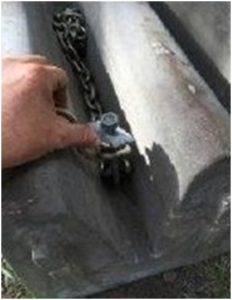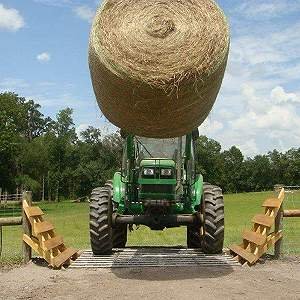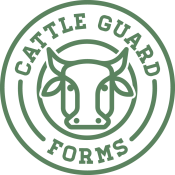What is the best way to pick up and put in place concrete cattle guard once it has been cast, flipped over and ready to put in place?

Adding a pair of j-bolts will easily let you attach a chain, which can be lifted with your tractor.
Simply place two 8 inch J-bolts in addition to the Two 10 inch J-Bolts. The 10 inch J-Bolts are used when you remove the form from the mold. The 8 inch J-Bolts are used to transport the form in the top-side up position to the location in which you will place the form.
In order to place the 8 inch J-Bolt all you need to do is drill a small hole in the plastic where you will see a little impression and place the 8 inch J-Bolts in before you pour. The 8 inch J-Bolt will be in the gaps away from car traffic.
Why install our cattle guards above grade?
The Cow Stop cattle guard when poured has its own base. There’s no pit to dig out. When placing cattle guards, make sure they are taller than ground in the fence opening. This does two things. First, it raises the Cow Stop up so debris and dirt wash out naturally. Second it make the cows even more reluctant to cross because it creates an even more uncomfortable footing for the cow.
When combining multiple Cow Stops for large openings, grade the area so the forms make a speed bump (hump) to make the cows even more leary of crossing. Painting the tops of the forms bright yellow also confuses the cows, giving them one more reason not to test walking on them!
Do these cattle guards come with the rebar already installed?
Our Texan stay in the Ground cattle Guard Form you buy has been engineered with pre-installed rebar already set to meet the HS-20 Standards!
Our Reusable cattle guard does not come with rebar (you will buy ½” rebar and install)
How much concrete does each 8′ x 6′ Texan form need?
You will need 1 1/3 cubic yards for each 8′ × 6′ Texan form. The best and fastest way to get the job done is to order a ready mix concrete truck asking for a 4,000 psi at a slump of 6 or 7.
Slump is simply a measure (1-10) to gauge the consistency of concrete. A slump of 7 will enable you to pour and move the concrete into each beam with minimal effort…
*NOTE: WE PROVIDE YOU COMPLETE INSTALLATION DETAILS IN WRITING, VIDEO, and PHONE SUPPORT IF NEEDED.
The usual cost to order a concrete truck ranges from $80-$100/cu.yd. Plus a $60-$100 delivery fee. Prices vary area to area, and the distance to the concrete company. The bottom line: An 8×6′ form (needing 1 1/3 cubic yards of concrete) will usually cost a maximum $250. Figure roughly $350 for two 8′ × 6′ forms.
The Cow Stop reusable cattle guard form takes 12 bags 80lb. Quickcrete (or equivalent) Be sure to get the 4000 PSI mix!
Why do you only offer an 8×6′ FORM?
We don’t! Both of our products are sized differently.
The Texan form is 8′ x 6′ to make it easier to ship! If you put two side by side you get a 16′ cattle guard.
The Cow Stop reusable form creates a guard that is 22″ x 6′. Although the Cow Stop is smaller, it is designed to be laid out in a grid like brick pavers or building blocks to create whatever size opening you need.
 If you put “wings” on each end of the cattle guard, you can make the effective width of the cattle guard up to four feet wider. Thus two forms side by side can serve gate openings from 16 to 20 feet across.
If you put “wings” on each end of the cattle guard, you can make the effective width of the cattle guard up to four feet wider. Thus two forms side by side can serve gate openings from 16 to 20 feet across.
Will these work as horse or deer guards?
While Cattle Guard Forms were not designed specifically with other animals in mind, we can say that we have the safest Cattle guards on the market because of our “Hoof Stop” technology. The gaps between our cattle guard beams are 5″ at the top, then narrow at the ground to 2″ which helps to keep animal’s hoof from getting caught or trapped. Other cattle guards allow the whole leg to go through and this could damage a horse or cow’s leg. Horses are especially prone to broken legs when caught up in a cattle guard with a pit.
We do know that some horse owners use our Texan cattle guards as a deterrent. Most deer or horse guards work by placing two – 8′ x 6′ cattle guards across an 8′ opening giving you a 12′ x 8′ span front to back. Just keep in mind that horses and deer are accomplished jumpers, so a third Texan might be necessary if you have an especially good long jumper on your team!
With our Cow Stop reusable cattle guard forms, you can make as many as you like to make a guard as wide or as long as you need.
Why do you offer a Form versus a steel cattle guard?
Our engineered concrete forms give you a huge advantage. You get more for less.
With our Cow Stop or Texan forms you can pour your own HS-20 concrete cattle guard for way less than what it would cost in steel.
Concrete cattle guards are superior in strength and longevity compared to steel. Our “cast-in-place” Texan concrete form will give you a cattle guard that delivers better protection against horizontal or vertical impacts and most importantly weather and water.
Steel cattle guards have traditionally sold more often because they’re cheaper to make and lighter (and less expensive) to ship compared to concrete.
Having said that, steel cattle guards are still heavy (Many times heavier than our form). So heavy that you’ll have to have a forklift to offload. Our Texan concrete form (pre-installed with high-tensile strength light-weight GFRP rebar) weighs only 140 pounds.
Our Cow Stop reusable cattle guard form weighs only 78 pounds.
When either form is filled with 4000 PSI concrete, the resulting cattle guard is fully rated for HS-20 loads (18-wheelers) and are superior to steel cattle guards for durability, and safety for your herd.
What kind of loads will your finished cattle guard support?
We engineer our Cattle Guard Forms to meet the same strict specifications used by the U.S. government in building bridges and interstate highways. All of our products are certified by accredited professional engineers to meet an HS-20 load rating or 32,000 pounds per axle. To put that in perspective, a loaded 120 HP John Deere weighs about 12,000 pounds. Which is only 6 to 7,000 pounds over the rear axle.
Can it support a loaded semi?
Whatever the US DOT allows on the highways, these cattle guards can handle. The DOT limits the weight of a standard 5-axle tractor trailer on interstate highways to 80,000 lbs. (20,000 lbs over a single axle, 34,000 over dual axles).
An “economy” steel cattle guard would collapse under these stresses. Which is why our cattle guards are superior to steel guards.
Because you pour the concrete at your location you can save hundreds or even thousands of dollars over installing old school cattle guards. And you still get a superior product!!
A 12 ft. by 6 ft. cattle guard, made with our reusable Cow Stop form, will cost you less than $1,600. Compare us to any other product on the market, and you’ll see why so many farmers say: Buy one, make more. It’s simple.
Will cows try to cross concrete cattle guards?
Q: I am interested in your product. I am wondering if the cattle try to cross the guard? We have 2 of the traditional guards on our property and as the dirt and weeds grow the cows want to cross the guard. From what I understand, cows won’t cross if they can’t see the ground and the footing is unstable on the guard. I believe your product has the unstable footing feel but what about the fact that they can see the bottom?
A: All cows will eventually try and cross all cattle guards if they fill up with dirt.The key is to elevate them as much as you can so that rainwater will be detoured around the cattle guard rather than sending water and debris inside.
Cows need a firm place to walk and the gaps make it uncomfortable for them to cross so if they try they will simply become uncomfortable and back away from the cattle guard. Our product is pit-less therefore if a cow attempts to cross, he will not break his leg.
It does not matter if a cow sees dirt or concrete, they simply are concerned with the gaps because the size of the gap interrupts their feeling of stability.
What is the stability of concrete cattle guards when used with bulldozers?
Q: Can the concrete cattle guards take being run over by dozers? It is not uncommon to find dozers from smaller D4s to D8s on ranches in NM. How well will they stand up to being driven across by the steel tracked dozers?
A:Yes the HS-20 cattle guard will easily handle the dozer because the weight is well distributed on its long wheel track base. However, you should cushion the top with plywood or boards to keep the sharp steel tracks from grinding or chipping the tops of the cattle guard.




